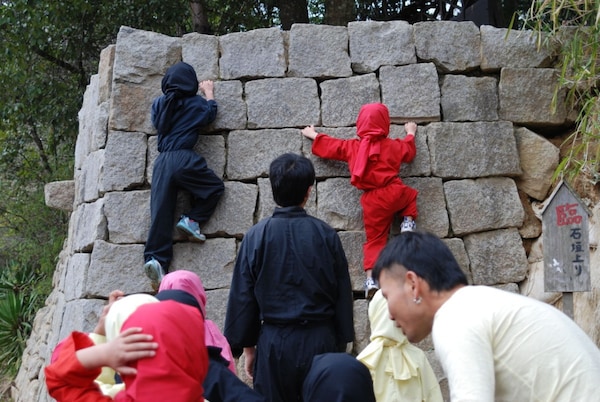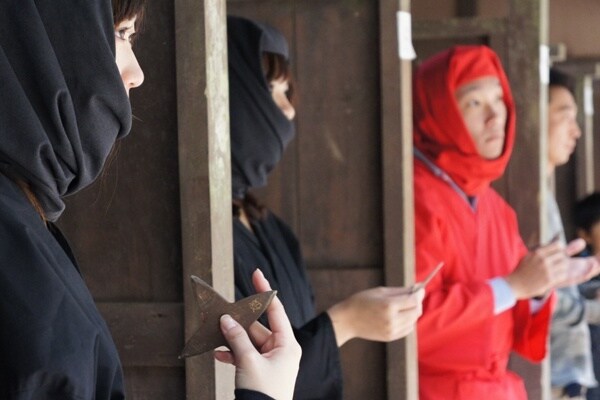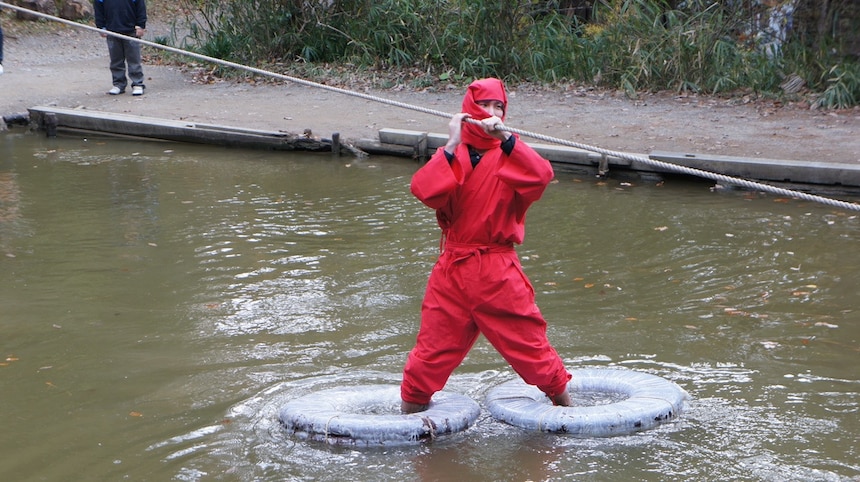Ninja for a Day: Koka Ninja Village
We all know the stereotype: silent assassins dressed in black, leaping from rooftops in order to prey on their unsuspecting victims. It's the way Hollywood movies seem to have portrayed ninjas since James Bond’s chopper touched down in Japan and he was offered the use of a secret service force in 1967's You Only Live Twice.

http://blog.livedoor.jp/peacefulchild/archives/51784100.html
The reality, though, is somewhat different. One thing is for certain: they were a largely secret group, and their history is shrouded in mystery and intrigue—something that, for many, adds to their appeal.
A group from Tokyo Weekender took a trip to Koka, in Shiga Prefecture, home of the Koka Ninja Village, to find out more.
What You Thought You Knew

http://www.tokyoweekender.com/2013/06/becoming-a-ninja-in-shiga/
Koka was the location for part of 3 Ninjas, a slightly dodgy 1992 kids’ movie you may remember slightly more vaguely than that Japan-set Bond flick. But going further back, the area hosted one of Japan's most prominent schools of ninjutsu—usually translated as "the way of stealth," though nin (忍) literally means forbearance and jutsu (術) means technique. Hidden away deep in the forest, this was said to be an ideal spot to learn about the arts of espionage, sabotage and infiltration.
When we reach Koka we meet Akira Kitazawa, a ninja expert in the process of translating thousands of pages of historical documents into modern-day Japanese in order to give people a better understanding of who this secretive group really were.
Firstly, he takes us to the changing room. What better way to understand their true appearance, mask and all, than by getting dressed up ourselves? At least that’s what we thought. But while the outfits at Koka Village actually do fit the Hollywood mold—and are all the more fun for it—ninja clothing was in fact much more varied.

http://www.tokyoweekender.com/2013/06/becoming-a-ninja-in-shiga/
“There is no such thing as a ninja costume,” says Kitazawa. “Think about it: if there were, people would recognize them far too easily. They basically wore clothes like everybody else. They had something known as shichi-hode (seven disguises), where they would appear in various forms, such as peasants, travelers, salesman of medical goods, and so on.”
Kitazawa also dismisses the notion that ninja were deadly assassins or secret agents who would constantly eliminate enemies, but does allude to their difference from more "chivalrous" samurai, whom they are not to be confused with. He describes them as a “vigilante group who lived in a feudal system with a strict class divide and therefore tried hard to make their lives better by any means possible.”
So where did this depiction of them as brutal killers come from? According to Kitazawa, it goes back over 400 years. “In 1600, at the end of the Sengoku (Warring States) Period, after peace had finally arrived, ninja started to use their skills in the entertainment industry, like kabuki and street performing,” he says. “This helped to create this image that we see in movies today, which is actually quite different to what they were really like.” Essentially, they hammed up their ruthlessness for action-hungry audiences.
Becoming a Ninja
https://www.youtube.com/watch?v=Tz2EYH-Ofko
As he talks, Kitazawa shows us around the complex, starting in the museum. It's a small, dark room, rather apt for a group that wanted to keep a low profile. There's a mixture of exhibits on display, including ladders, items of clothing, documents, training manuals, tools for making medicine (selling medicine was a good way of "gathering information" from—spying on—people), and a diagram of some cats’ eyes, which Kitazawa says were used to tell the time (if the iris was almost closed it was noon, if dilated it was late at night).
The centerpiece of the museum is a collection of weapons, such as blow-dart guns and shuriken, the latter of which we get to practice throwing in the Shuriken Dojo hall. The wooden target is only a few meters (yards) away, yet we still manage to make the act look tricky; perhaps we're not quite ready for ninja status yet!
https://www.youtube.com/watch?v=kkYYgPp7lY8
Kitazawa tells us the shuriken (its name literally means "sword hidden in the hand") was used in a variety of different ways by ninja. As well as slinging them at their assailants, some hid them in their palms for a more slicing slap or chop, while others simply kept them as charms. They’d be extremely bad luck for those on the receiving end, however, as their blades would often be laced with poison such as aconite or horse droppings, meaning one small nick could lead to lockjaw or worse.
Ninja basically did whatever they could to survive and thrive, and had innovative ways to do so. This is evident as we take a tour of the ninja house that belonged to the Fujibayashi family in the mid 1800s. There are trap doors, fake doors, escape hatches and a number of other hidden compartments. Giving a real insight into the mind of the ninja, it's probably the most interesting attraction at the village.
There are also a number of fun activities that are particularly good for children such as climbing walls, swinging ropes, pottery classes and the Mizugomo Water Spider Pond, where you attempt to get across the water using two floating rings and a rope. A fun day out for people of all ages, it's well worth a visit, even if you only have a passing interest in the art of ninja!
Read full story: www.tokyoweekender.com




